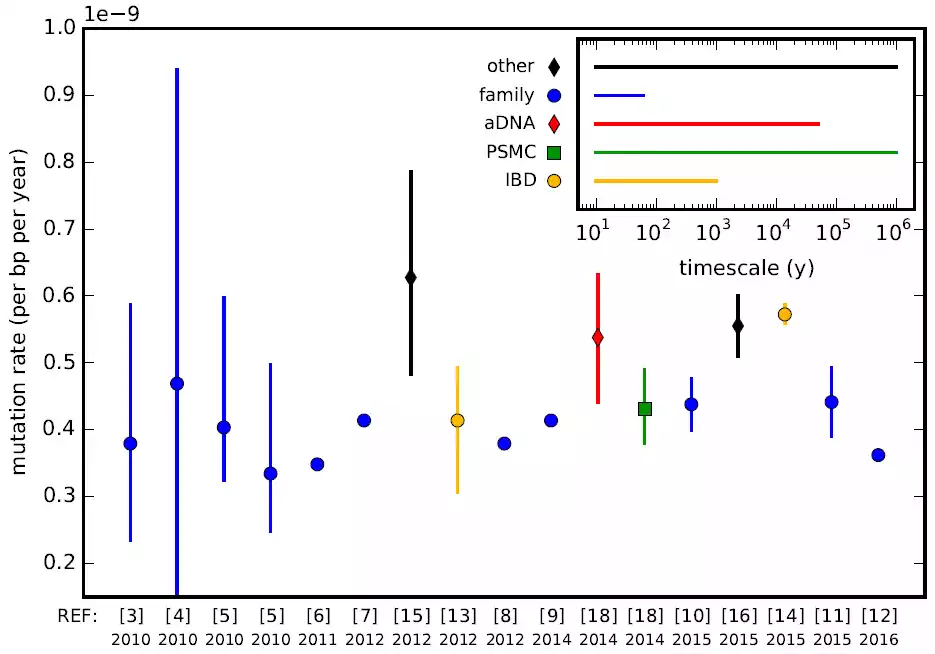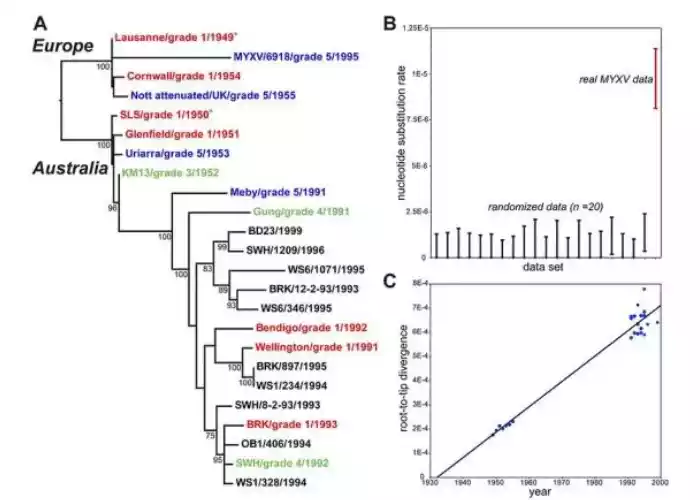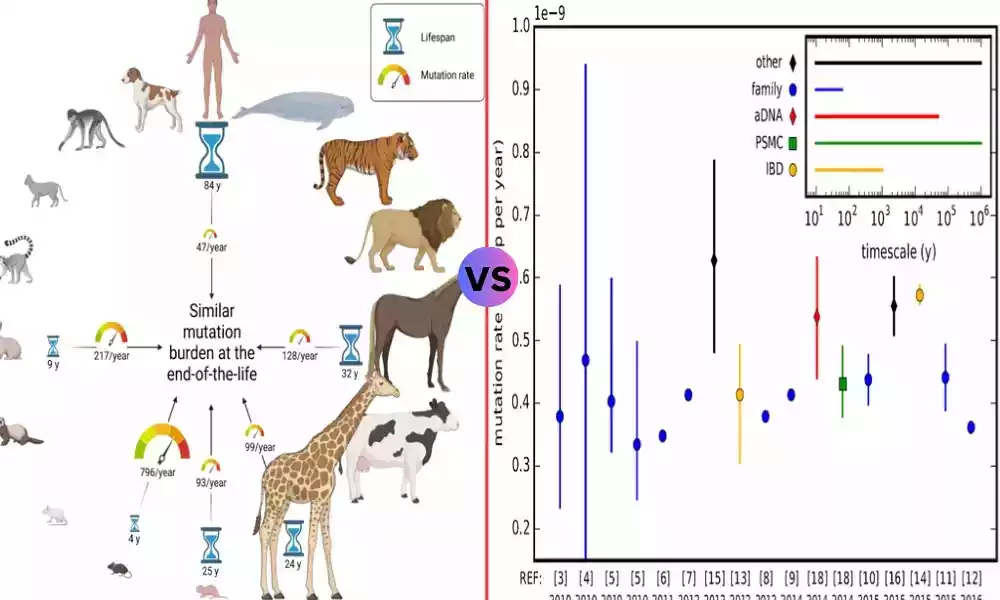DNA, the molecular cornerstone of life, is subject to change over time. These changes can be categorized into Mutation Rate and Substitution Rate. The mutation rate describes how frequently new genetic alterations arise in a DNA sequence, often due to replication errors or external factors.
Conversely, the substitution rate gauges how often a specific mutation becomes the new norm in a population. Understanding these rates is fundamental in tracing evolutionary pathways and the dynamics of genetic variation.
Brief overview of genetic changes
Brief Overview of Genetic Changes
At its essence, every form of life, from the smallest microorganism to the largest mammal, operates based on a genetic code stored within DNA (or RNA in some viruses). This code isn't static; it changes over time, leading to genetic variation.
Here's a brief overview:
- What are Genetic Changes?
-
- Alterations in the sequence of nucleotides (A, T, C, G) within DNA or RNA.
- Can occur in coding regions (affecting proteins) or non-coding regions.
- Types of Genetic Changes
-
- Point mutations: A single nucleotide change. For example, an 'A' might change to a 'G'.
- Insertions & Deletions (Indels): Addition or removal of one or more nucleotides.
- Duplication: A sequence of nucleotides is repeated.
- Translocations: A segment of DNA moves from one location to another.
- Inversions: A segment of DNA is reversed.
- Causes of Genetic Changes
-
- Internal Factors:
-
-
- DNA replication errors.
- Molecular activities, like recombination.
-
-
- External Factors:
-
-
- Radiation (e.g., UV light).
- Chemical mutagens.
- Viral integration.
-
- Implications of Genetic Changes
-
- Beneficial changes: Drive evolution by conferring advantages, leading to better survival or reproduction.
- Neutral changes: No immediate effect on the organism's fitness. Can become beneficial or detrimental over time due to environmental shifts.
- Detrimental changes: Harmful effects on the organism, often leading to diseases or decreased fitness.
- Role in Evolution
-
- Genetic changes lead to variation within populations.
- Natural selection acts upon this variation, influencing which genetic changes become prevalent or disappear.
Understanding these genetic changes offers insights into how life evolves, adapts, and diversifies over time. From the mechanisms of disease to the branching paths of evolution, these changes are central to the story of life on Earth.
Definition of Mutation Rate and Substitution Rate
Definition of Mutation Rate and Substitution Rate
- Mutation Rate:
-
- The mutation rate refers to the frequency at which new genetic alterations, or mutations, occur in a given gene or DNA sequence over a specific period. It measures how often changes in nucleotide sequences arise, either due to inherent errors in DNA replication, external factors like radiation or chemicals, or other endogenous processes.
- Essentially, it quantifies how often a DNA sequence is modified or changed.

- Substitution Rate:
-
- The substitution rate, on the other hand, assesses the rate at which one genetic variant (a specific nucleotide or set of nucleotides) replaces another in the genetic makeup of a population and becomes the prevailing form. It reflects the changes that are retained and "fixed" in a population over time, indicating which mutations have been accepted and perpetuated through generations.
- In essence, it measures how often a particular mutation becomes the new standard or "norm" in a population.
While both rates are integral to understanding genetic and evolutionary dynamics, they offer different perspectives: one on the immediate emergence of changes (mutation rate) and the other on the long-term acceptance of those changes in populations (substitution rate).
Factors Affecting Each Rate
Factors Affecting Mutation Rate and Substitution Rate
- Mutation Rate
-
- DNA Replication Mechanisms and Errors
-
-
- DNA polymerase fidelity: The accuracy with which DNA polymerases replicate DNA.
- Mismatch repair mechanisms: Systems that identify and repair incorrect pairings.
-
-
- DNA Repair Mechanisms
-
-
- Base excision repair, nucleotide excision repair, and double-strand break repair: Processes that identify and correct damaged DNA.
-
-
- External Factors
-
-
- Radiation: Ultraviolet (UV) light, X-rays, and gamma rays can damage DNA.
- Chemicals: Mutagens, such as those found in tobacco smoke or certain industrial chemicals, can induce mutations.
- Viral Integration: Some viruses can integrate into host genomes, causing mutations.
-
-
- Biological Processes
-
-
- Mobile genetic elements: Transposons can cause insertions, deletions, or rearrangements.
- Recombination: The exchange of genetic material can introduce mutations if not properly repaired.
-
- Substitution Rate
-
- Natural Selection
-
-
- Positive Selection: Beneficial mutations increase in frequency until they're fixed in the population.
- Negative Selection: Detrimental mutations decrease in frequency.
- Neutral Evolution: Mutations that neither benefit nor harm the organism can become fixed by chance.
-
-
- Genetic Drift
-
-
- Random fluctuations in allele frequencies, especially in small populations, can lead to the fixation of mutations irrespective of their benefit or detriment.
-
-
- Population Size and Structure
-
-
- In smaller populations, genetic drift has a stronger influence, potentially leading to a higher substitution rate.
- In structured populations (with limited gene flow among subpopulations), local substitutions might occur.
-
-
- Mutation Rate
-
-
- Ironically, the mutation rate itself affects the substitution rate: the more mutations that occur, the more raw material there is for potential substitutions.
-
-
- Other Evolutionary Forces
-
-
- Gene flow, migration, and bottleneck events can also influence the substitution rate by altering the genetic makeup of populations.
-
While the mutation rate is primarily influenced by factors related to DNA maintenance and environmental exposures, the substitution rate is more influenced by evolutionary processes and population dynamics.
Mutation Rate and Substitution Rate in the comparison chart
Here's a comparison chart contrasting Mutation Rate and Substitution Rate:
Mutation Rate vs. Substitution Rate
| Parameter | Mutation Rate | Substitution Rate |
| Definition | The frequency at which new genetic alterations occur in a DNA sequence. | The rate at which one genetic variant becomes fixed in a population, replacing another. |
| Cause | DNA replication errors, external factors (e.g., radiation, chemicals), and biological processes. | Evolutionary processes like natural selection, genetic drift, and population dynamics. |
| Time Perspective | Immediate: Represents changes at the molecular level as they happen. | Long-term: Reflects changes retained and perpetuated over many generations. |
| Level of Occurrence | Individual level: Occurs in individual organisms. | Population-level: Involves changes fixed in a population. |
| Factors Influencing | DNA replication fidelity, repair mechanisms, environmental mutagens, viral integration. | Natural selection, genetic drift, population size and structure, mutation rate itself. |
| Outcome | Not all mutations result in a change at the population level. Some mutations are lost, while others persist but don't become fixed. | Represents mutations that have become the norm or "standard" in a population. |
| Implication | Provides raw material for evolution. Not all mutations lead to evolutionary adaptation. | Indicates evolutionary trajectories and reveals which genetic changes have been accepted by populations over time. |
This comparison chart succinctly distinguishes between the two rates, shedding light on their definitions, implications, and the factors influencing them.

Practical Implications of Mutation Rate and Substitution Rate
Practical Implications of Mutation Rate and Substitution Rate
Understanding both mutation and substitution rates has numerous real-world applications, influencing fields from evolutionary biology to medicine. Here's a look at some of these implications:
- Evolutionary Biology and Phylogenetics
-
- Historical Evolutionary Events: By analyzing substitution rates, scientists can infer the timings of historical evolutionary events, such as species divergences.
- Molecular Clocks: Combined with fossil evidence, these rates can serve as "molecular clocks" to estimate the time of divergence between species.
- Evolutionary Relationships: Substitution rates can help determine evolutionary relationships among species, constructing phylogenetic trees.
- Medicine and Genetics
-
- Disease Understanding: High mutation rates in certain genes can predispose individuals to specific diseases, such as cancer.
- Drug Development: Understanding mutation rates can help in predicting potential drug resistance, especially in fast-mutating organisms like bacteria and viruses.
- Genetic Counseling: Knowing the mutation rate of certain hereditary conditions aids in counseling prospective parents about potential risks.
- Microbiology and Virology
-
- Virus Evolution: RNA viruses, like the flu or HIV, have high mutation rates, influencing their evolution and the challenge of vaccine development.
- Bacterial Resistance: Knowledge about mutation rates can help predict the emergence of antibiotic-resistant bacterial strains.
- Conservation Biology
-
- Endangered Species: Understanding substitution rates can reveal the historical population sizes of endangered species, providing insights into their genetic health and vulnerability.
- Adaptation to Changing Environments: Recognizing how mutation and substitution rates contribute to adaptability can help conservationists devise strategies to aid species in rapidly changing environments.
- Agriculture
-
- Crop Improvement: Understanding the mutation rates of certain traits can aid in selective breeding or genetic modification for better crop varieties.
- Pest Control: Recognizing mutation and substitution rates can help in predicting pesticide or herbicide resistance in pests and weeds, respectively.
- Forensics
-
- Human Identification: Certain regions of DNA with known mutation rates can be used for forensic identification or paternity tests.
- Evolutionary Forensics: By analyzing substitution rates, scientists can trace back the origin of particular traits or genes in criminal cases involving bioterrorism or illegal trade in wildlife.
Mutation and substitution rates are not just theoretical concepts; they have a significant bearing on diverse fields. They play a pivotal role in shaping strategies and decisions, from health care and conservation to agriculture and forensics.
Common Misconceptions
Common Misconceptions about Mutation Rate and Substitution Rate
- All Mutations Lead to Substitutions:
-
- Misconception: Every mutation that occurs will eventually become a substitution.
- Reality: Many mutations are neutral or detrimental and may never become fixed in a population. Only a fraction of mutations become substitutions.
- High Mutation Rate Means Rapid Evolution:
-
- Misconception: If an organism has a high mutation rate, it will evolve more rapidly.
- Reality: While a high mutation rate provides more genetic variability, it doesn't guarantee faster beneficial evolution. Many mutations might be neutral or harmful.
- Substitution Rate Equals Mutation Rate:
-
- Misconception: The rate at which mutations occur is the same as the rate at which they become fixed in a population.
- Reality: These rates can vary significantly. While the mutation rate provides the potential for change, the substitution rate shows which of those changes have become established.
- Mutations Are Always Bad:
-
- Misconception: Mutations are harmful and lead to disorders or diseases.
- Reality: While some mutations can be harmful, many are neutral, and some can be beneficial, leading to evolutionary advantages.
- Only External Factors Influence Mutation Rates:
-
- Misconception: Only external factors like radiation or chemicals cause mutations.
- Reality: While external factors can influence mutation rates, internal factors like DNA replication errors or natural biological processes also play a significant role.
- Substitution Rate is Solely a Measure of Adaptive Evolution:
-
- Misconception: A high substitution rate always indicates positive selection and adaptive evolution.
- Reality: Substitutions can also arise from neutral genetic drift, especially in small populations.
- Mutation Rates are Constant Across All Organisms:
-
- Misconception: All organisms have similar mutation rates.
- Reality: Mutation rates can vary widely across organisms. For instance, RNA viruses typically have much higher mutation rates than most multicellular eukaryotes.
- Only Coding Regions Matter:
-
- Misconception: Only mutations in the coding regions of DNA (those that code for proteins) are significant.
- Reality: Non-coding regions can play vital roles in gene regulation, and mutations there can have profound effects.
Understanding the realities behind these misconceptions is crucial for a more accurate perception of genetic and evolutionary processes.
Examples in Nature
Let's delve into some real-world examples from nature to further elucidate mutation and substitution rates:
- Flu Virus (Influenza)
-
- Mutation Rate: The flu virus, particularly RNA-based influenza, has a notably high mutation rate. This rapid mutation rate is why we observe new strains of the flu virus nearly every year.
- Substitution Rate: Over time, certain mutations in the flu virus become dominant, leading to established strains that can sometimes evade the immunity provided by prior infections or vaccinations. This substitution is often driven by selection pressures from host immune systems.
- HIV (Human Immunodeficiency Virus)
-
- Mutation Rate: HIV has a high mutation rate, which is one reason for its ability to evade the immune system and develop resistance to antiretroviral drugs.
- Substitution Rate: In the presence of antiretroviral drugs, mutations that confer drug resistance can become fixed in the viral population, resulting in a dominant drug-resistant strain.
- Cheetahs
-
- Mutation Rate: Cheetahs, like all organisms, experience genetic mutations.
- Substitution Rate: Historical population bottlenecks have drastically reduced the cheetah's genetic diversity. In such small populations, genetic drift can lead to a higher substitution rate, where random mutations can become fixed, irrespective of their adaptive value.
- Bacteria and Antibiotic Resistance
-
- Mutation Rate: Bacteria have a constant low-level mutation rate. When exposed to antibiotics, occasional mutations can lead to resistance.
- Substitution Rate: In environments with antibiotics, resistant mutations can become the norm, as non-resistant strains are eliminated. This process is a clear example of positive selection in action.
- Moths During the Industrial Revolution (Peppered Moths)
-
- Mutation Rate: Random mutations led to two main color variations in peppered moths: light and dark.
- Substitution Rate: Before the Industrial Revolution, lighter moths prevailed, being well-camouflaged against lichen-covered trees. But as pollution darkened trees, the dark-colored moths became more common due to increased survival—a direct example of a change in substitution rate due to environmental changes.
- Human Evolution and Lactose Tolerance
-
- Mutation Rate: Mutations arose in human populations that allowed lactose digestion to continue into adulthood.
- Substitution Rate: In societies that domesticated cattle and relied on milk as a food source, individuals with lactose tolerance had a survival advantage. Over time, the lactose-tolerant mutation became predominant in such populations, indicating its substitution.
These examples showcase how mutation and substitution rates, influenced by environmental pressures, genetic drift, and other factors, play out in real-world scenarios. They underline the dynamic interplay of genetic variation and evolutionary forces in shaping the diversity of life.
Conclusion
Mutation and substitution rates are pivotal in understanding the dynamics of genetic variation and evolutionary change. While the mutation rate provides the raw material for potential evolutionary shifts, the substitution rate reveals which changes have been accepted and perpetuated in populations over time.
Through real-world examples, from rapidly mutating viruses to evolutionary shifts in larger organisms, we witness the profound impact these rates have on shaping biodiversity and adaptability. Recognizing the distinctions and interplay between these rates is crucial for insights into evolutionary biology, medicine, and conservation.

